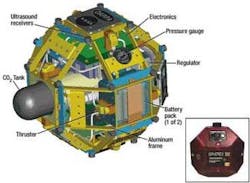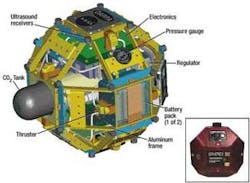By John McHale
CAMBRIDGE, Mass. — Engineers at Payload Systems Inc., with the help of the Massachusetts Institute of Technology (MIT), have designed bowling ball–sized satellites that will fly on the International Space Station to enable researchers to test docking, formation flying, and other multispacecraft maneuvers in multigravity.
The small satellites, called Synchronized Position Hold, Engage, and Reorient Experimental Satellites (SPHERES), comprise a test bed for maneuvering satellites and orbiting telescopes, Payload Systems officials say.
Without experiments like SPHERES, NASA would have to spend a significant amount of time and money figuring out how to get the most out of these types of high-test equipment, company officials say. Payload Systems and MIT are in Cambridge, Mass.
Funding for SPHERES flight- systems development and integration comes from the U.S. Defense Advance Research Projects Agency (DARPA) in Arlington, Va., the NASA Goddard Space Flight Center in Greenbelt, Md., and the NASA Jet Propulsion Laboratory in Pasadena, Calif. The U.S. Air Force sponsors the SPHERES space station manifest assignment, Payload Systems officials say.
Potential military applications include terrestrial mapping and missile launch detection; at least one satellite is watching at all times, says Steve Sell, SPHERES project manager at Payload Systems.
The mini satellites do not fly autonomously, but have preprogrammed instructions, Sell says.
Scientists plan to use SPHERES to help them improve space observation capability by combining information from the apertures of several telescopes. Such capability would augment telescopes such as the Hubble Telescope, which have a visual acuity that is limited by the diameter of the primary mirror, Payload Systems officials say.
SPHERES will help scientists develop the software algorithms necessary to combine and control apertures from the new Terrestrial Planet Finder (TPF) telescope and other similar telescope arrays. The arrays would increase visual acuity essentially by substituting several small separated mirrors for one large mirror.
In addition, SPHERES research conducted aboard the space station will aid in the design of rendezvous and docking maneuvers for constellation and array spacecraft configurations, company officials say.
The SPHERES flight complement consists of three self-contained satellites, each with battery power, a cold gas propulsion system, communications, and navigation equipment, Sell says. Using ultrasound transmitter beacons aboard the space station, the satellites individually measure their respective positions and attitudes in relation to one other.
Key off-the-shelf electronics include a Texas Instruments digital signal-processor C6701 chip, a field-programmable gate array (FPGA) from Xilinx, and AA batteries, Sell says. The FPGA processes the acoustic signal and the DSP measures attitude within the spacecraft. Each SPHERE has an accelerometer and gyroscope. The satellites are all controlled via a laptop computer, Sell notes.
SPHERES helps researchers on the ground quickly test control algorithms on the space station, receive testing data, then refine and uplink new algorithms, Payload Systems officials say.
The SPHERES project began as an experimental undergraduate design course at MIT in which students designed, built, and operated prototype hardware on the NASA KC-135 reduced-gravity simulation aircraft, Sell says. Payload Systems provided teaching and technical support for the course, and is responsible for the design and fabrication of flight hardware systems as well as space shuttle and space station integration.
For more information on Payload Systems contact the company online at www.payload.com.




